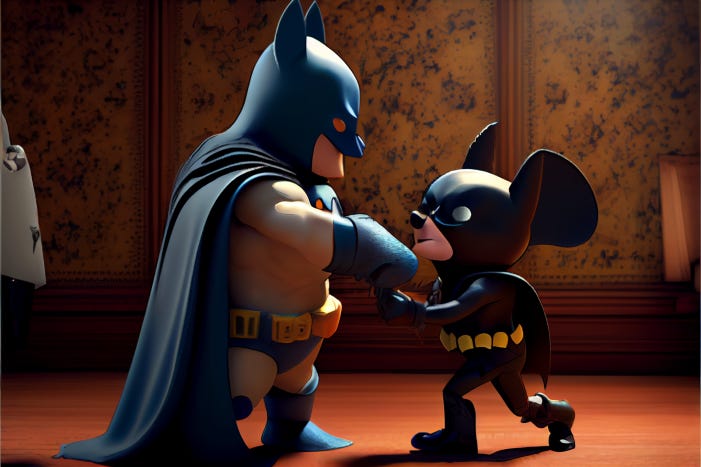Disney and Warner Bros have a rivalry that dates back to the 1920s, and each holds a legacy built on exclusive intellectual property (IP). Both companies originally started as movie studios in 1923, and they’re still leading the way in the Web3 age of the creator economy, artificial intelligence, and blockchain technology.
Of course, there’s a new player on the block (Netflix) that carved its own lane in the media ecosystem and released some NFT hits itself.
Batman vs. Mickey Mouse by MidJourney
The crypto market is a far cry from its historic highs, Bitcoin’s 2% market depth shows a lack of liquidity post-FTX, but NFT sales are up so far this year. Although interest may be waning, brands like Disney, Warner Brothers, and Netflix can help the sector retain mainstream relevancy.
Business leaders wondering how to successfully port their brands and other IP across evolving media and technology can learn a lot from watching these three titans navigate the bleeding edge of Web3 entertainment.
In fact, let’s put them head to head to examine how to replicate their wins and avoid their losses.
Disney’s Blockchain Ambitions
Disney was ahead of the curve in 2014 when it created Dragonchain, a hybrid blockchain platform focused on enterprise.
By 2016, it was made open-source, a surprising move from a company that typically shuns the public domain. The company has since pivoted to Ethereum while supporting Polygon (MATIC), the sole Web3 project in its 2022 accelerator program last summer.
It’s these moves that give Disney the credentials to back its NFT drops. It’s not simply selling images–it contributes to the entire ecosystem.
The House of Mouse has NFTs for its Star Wars, Marvel, and Pixar brands on VeVe, which is geared toward digital collectibles. The Disney/Pixar digital collectibles, known as “Golden Moments,” started at $40 and included three free months of Disney+ membership. It also has a variety of Marvel collections, such as Ultraman, Marvel Mighties, and the Marvel Artworks series. This is on top of its partnerships, including co-branded NFTs with Cinemark.
Meanwhile, ESPN partnered with Autograph (an NFT startup from legendary NFL quarterback Tom Brady) to release NFTs based on its sports content, while National Geographic’s Genesis Collection features a variety of artists and went on sale this month. However, it was largely criticized for missing the mark of its target audience–nature lovers who aren’t necessarily interested in digital collectibles.
On the other hand, Disney avoids mainstream NFT marketplaces like OpenSea to minimize costs and gets a 6% cut off secondary sales. Not only that, but last Fall, the Walt Disney Company posted a job opening for principal counsel specializing in NFTs, decentralized technology, and the metaverse. Although Disney has not publicly shared how much money its made from these efforts, the fourth quarter and fiscal year Earnings Report of 2022 cited that they grew 9% and 23%, respectively.
These are all essential moves brands should take note of to control costs while safely releasing their NFT collections.
Disney Golden Moments NFTs of Iron Man and The Simpsons by MidJourney
Supporting the community and fandoms authentically is the secret ingredient to Disney’s early successes in Web3. It releases artwork and content its fans crave with limited edition drops and special perks aimed directly at collectors. This helped the company maintain credibility with its IP while providing value to the community and generating enough revenue.
Some notable omissions from Disney’s Web3 foray thus far include Web3 movies, games, and phygital (digital+physical) collectibles. We also haven’t seen any efforts to tokenize passes to its Disney theme parks and cruises, and it’s lacking in community building, with scattered fan Discords being more visible than any official Disney server.
If it can fill those gaps, it will be a force to be reckoned with in the coming years.
Disney’s Web3 Grade: A-
Warner’s Web3 Attempt(s)
Warner Bros Discovery has a slightly different take on Web3, teaming up with a variety of blockchains and marketplaces to release a stream of NFTs. It teamed with Nifty for a series of collections based on Looney Tunes, The Matrix, and, most recently, Game of Thrones.
GoT recieved criticism on Crypto Twitter over uninspiring artwork and minting delays, but it sold out the collection in the midst of a quiet NFT winter, proving the brand has staying power with fans.
Game of Thrones NFTs on Nifty’s
It partnered with Coinbase NFTs for a series of Christmas cards last month based on characters like Superman, Scooby-Doo, Superman, and more.
Over the holidays, the company also teamed with Web3 startup Eluvio to release NFT collections based on its popular Lord of the Rings series. Although the Matrix IP was used for profile pics (PFPs), the Lord of the Rings collection included a copy of the movie, along with special-edition collectible images. Unfortunately, they failed to sell out, prompting analysts to ponder if the series will continue.
Warner Brothers’ DC imprint is selling collectible comic-based artworks on the Palm blockchain, and although it followed a year behind rival Marvel, the collections are generally well received. Both collections are selling well, so the consumer is ultimately the winner in the battle between Marvel and DC. NFTs, give their fans a way to own a digital piece of historic physical releases in ways that were previously inaccessible.
Warner Brothers also partnered with The Spot Room and Freeman jewelry for a phygital NFT collection over the holidays that attached NFT ownership to Potterworld-inspired jewelry, bringing magic to Web3. Discovery also has a collection of eco-friendly Shark Week-themed NFTs available on Nifty.
Although Warner Brothers is doing better than Disney in bridging real-world ownership with blockchain-based tokenization, it hasn’t found consistent wins across all brands. And it would be great if HBO Max subscriptions were included. However, it continues to prove there’s a market for digital collectibles even in the most bearish of markets, so you shouldn’t fear entering Web3 based on market conditions.
Warner’s Web3 Grade: B-
Netflix’s NFT Campaign
Netflix is the newest company on this list, and it became a titan of Web2 as part of the fabled FAANG index (a group of high-performing stocks, alongside Facebook, Amazon, Apple, and Google) in the 2010s. Although it disrupted the traditional entertainment industry with its DVD-by-mail and streaming services, the company barely dipped a toe in Web3.
Last summer, the streaming giant partnered with Candy Digital for a series of Stranger Things NFTs. It also launched an NFT scavenger hunt for Love, Death + Robots, that also helped it measure audience engagement with its in-house IP. The company hid QR codes across the internet and led over 32,000 people on a quest to gain mint access, and a look at OpenSea prices gives an idea of the most popular episodes.
We’re likely to see more NFT collections coming out as Netflix continues its push to legitimize its owned IP. And there are plenty of crypto- and blockchain-related documentaries on the platform for those looking to learn more about the industry. However, the company’s temporary forays into the world of Web3 are inconsistent at best.
Despite having novel release ideas, the lack of consistent community participation and rewards pushes Netflix’s efforts just below average.
Your brand should put enough effort and resources into its Web3 releases to consistently retain confidence in the community. Otherwise, you risk looking like a cash grab or rug pull.
Netflix’s Web3 Grade: C-
Web3 Winner: Disney
Disney’s blockchain contributions are numerous, and it separated itself from the pack by creating an open-source blockchain solution while seeking innovative Web3 startups to back. Its platform-agnostic experiments with a range of solutions keep providing the best value to its community.
By combining its legacy IP with modern business sense, I expect we’ll see more coming from Disney soon. One can only hope its next drop involves lifetime passes to a Disney theme park. With its rabid following, this is sure to be a headline-making sellout that maintains value on the secondary market for generations.
If your brand wants to follow in the footsteps of Disney and other brands pioneering Web3, be sure you’re consistent, authentic and provide value to your fans.
Lena Grundhoefer is the Founder of ZEITG3IST, a globally-recognized digital marketing and strategy agency. Through future-proof marketing solutions for the brands of tomorrow, we help Fortune 500 companies as well as brands just starting out break into web3.








